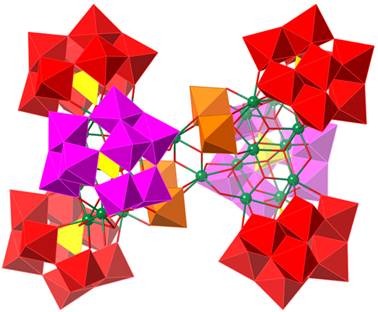
Researchers Reveal Synergistic Directing Syntheses of Lacunary Oxo Clusters
Jun 10, 2014 Email"> PrintText Size

Compared to late-transition-metal-substituted polyoxotungstate (POT) clusters, the former-transition-metal-substituted POTs are less developed because of their synthesis is difficult. Up to now, the maximum number of Zr atoms in Zr-substituted POTs under conventional solution syntheses (below 100°C, atmosphere pressure) is only six. It has reported that the Zr-substituted POTs possess good catalytic properties. Therefore, how to make the high-nuclear Zr-substituted POTs and further apply to the useful catalytic reactions is a challenging topic.
Recently, Prof. YANG Guoyu’s group at Fujian Institute of Research on the Structure of Matter, Chinese Academy of Sciences, has made a great progress in the synergistic directing syntheses of lacunary sites of the POT fragments.
An unprecedented Zr24-cluster-substituted POT hexamer was made by the synergistic directing roles of six lacunary POT fragments, showing the maximum Zr atoms and the largest Zr24-cluster in all the Zr-substituted POTs to date, which possesses distinct redox properties and Lewis acidity and plays a key role in the catalytic conversion from thioethers to sulfoxides/sulfones (J. Am. Chem. Soc., 2014, 136, 5065). The successful synthesis of the gigantic Zr24-cluster-substituted POT provides not only a direction for introducing other high valence metal cations into lacunary POTs under hydrothermal conditions but also a chance for selecting novel catalyst.
Previously, Prof. YANG's group had established the hydrothermal method for making the transition metal substituted polyoxometalates (POMs) via lacunary POM fragments as the precursors and proposed an innovation strategy of the lacunary directing syntheses (ChemComm, 2007, 1858), and then further developed this strategy to the synergistic directing between two or more lacunary fragments, the cooperation of the lacunary directing of POM fragments and the directing assembly of the organic ligands, as well as the combination between the lacunary directing and the decomposition of POM fragments, which have been published in Angew. Chem. Int. Ed. (2008, 47, 3909; 2009, 48, 7176), J. Am. Chem. Soc. (2010, 132, 15102), and Chem. Soc. Rev. (2012, 41, 7623-7646) respectively.


Structures of the hexamer (top) and Catalytic Oxidation of Thioethers(bottom) (Image by Prof. YANG’s group)
Compared to late-transition-metal-substituted polyoxotungstate (POT) clusters, the former-transition-metal-substituted POTs are less developed because of their synthesis is difficult. Up to now, the maximum number of Zr atoms in Zr-substituted POTs under conventional solution syntheses (below 100°C, atmosphere pressure) is only six. It has reported that the Zr-substituted POTs possess good catalytic properties. Therefore, how to make the high-nuclear Zr-substituted POTs and further apply to the useful catalytic reactions is a challenging topic.
Recently, Prof. YANG Guoyu’s group at Fujian Institute of Research on the Structure of Matter, Chinese Academy of Sciences, has made a great progress in the synergistic directing syntheses of lacunary sites of the POT fragments.
An unprecedented Zr24-cluster-substituted POT hexamer was made by the synergistic directing roles of six lacunary POT fragments, showing the maximum Zr atoms and the largest Zr24-cluster in all the Zr-substituted POTs to date, which possesses distinct redox properties and Lewis acidity and plays a key role in the catalytic conversion from thioethers to sulfoxides/sulfones (J. Am. Chem. Soc., 2014, 136, 5065). The successful synthesis of the gigantic Zr24-cluster-substituted POT provides not only a direction for introducing other high valence metal cations into lacunary POTs under hydrothermal conditions but also a chance for selecting novel catalyst.
Previously, Prof. YANG's group had established the hydrothermal method for making the transition metal substituted polyoxometalates (POMs) via lacunary POM fragments as the precursors and proposed an innovation strategy of the lacunary directing syntheses (ChemComm, 2007, 1858), and then further developed this strategy to the synergistic directing between two or more lacunary fragments, the cooperation of the lacunary directing of POM fragments and the directing assembly of the organic ligands, as well as the combination between the lacunary directing and the decomposition of POM fragments, which have been published in Angew. Chem. Int. Ed. (2008, 47, 3909; 2009, 48, 7176), J. Am. Chem. Soc. (2010, 132, 15102), and Chem. Soc. Rev. (2012, 41, 7623-7646) respectively.


Structures of the hexamer (top) and Catalytic Oxidation of Thioethers(bottom) (Image by Prof. YANG’s group)
CAS Institutes
There are 124 Institutions directly under the CAS by the end of 2012, with 104 research institutes, five universities & supporting organizations, 12 management organizations that consist of the headquarters and branches, and three other units. Moreover, there are 25 legal entities affiliated and 22 CAS invested holding enterprisesThere are 124 I...>> more
Contact Us

Chinese Academy of Sciences
Add: 52 Sanlihe Rd., Xicheng District, Beijing, China
Postcode: 100864
Tel: 86-10-68597592 (day) 86-10-68597289 (night)
Fax: 86-10-68511095 (day) 86-10-68512458 (night)
E-mail: cas_en@cas.cn

